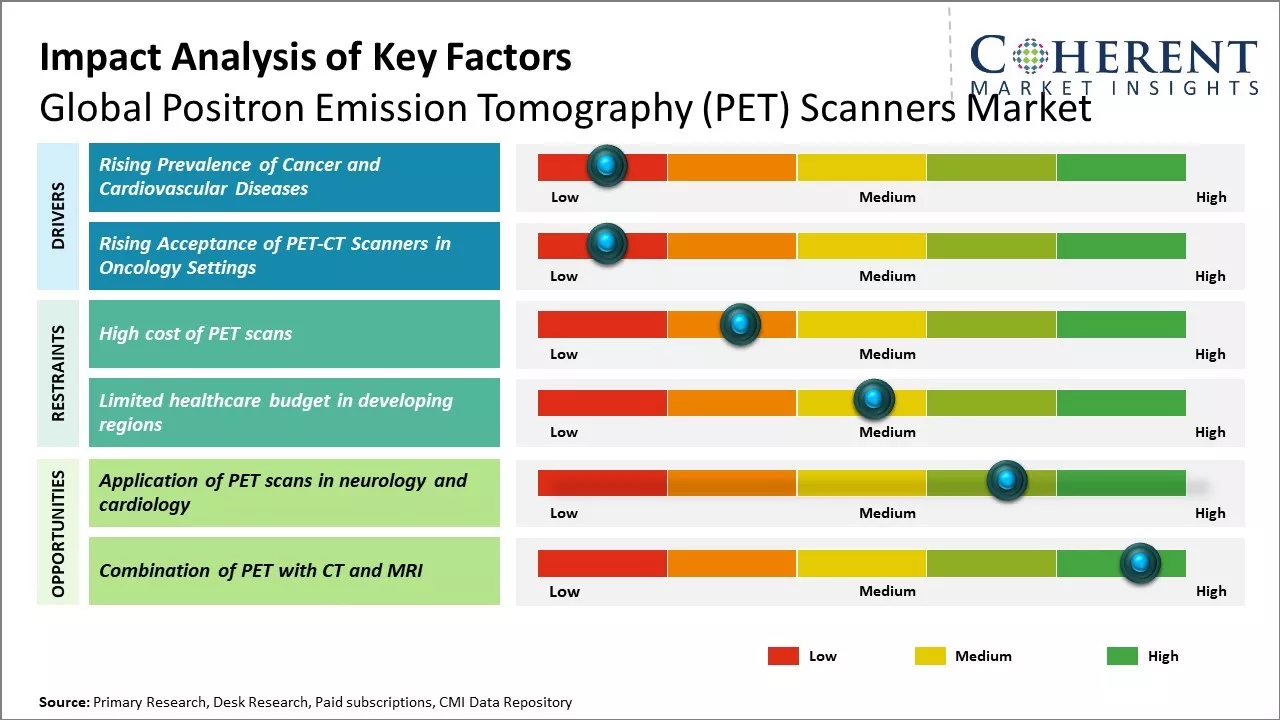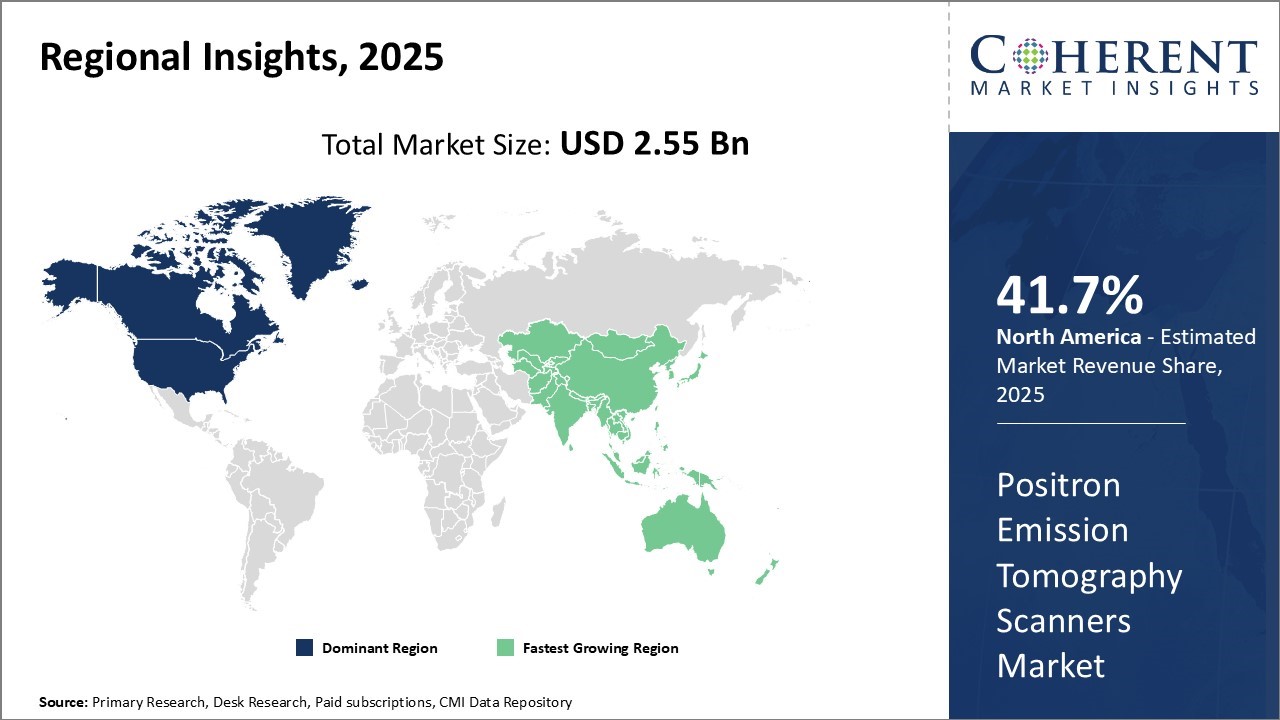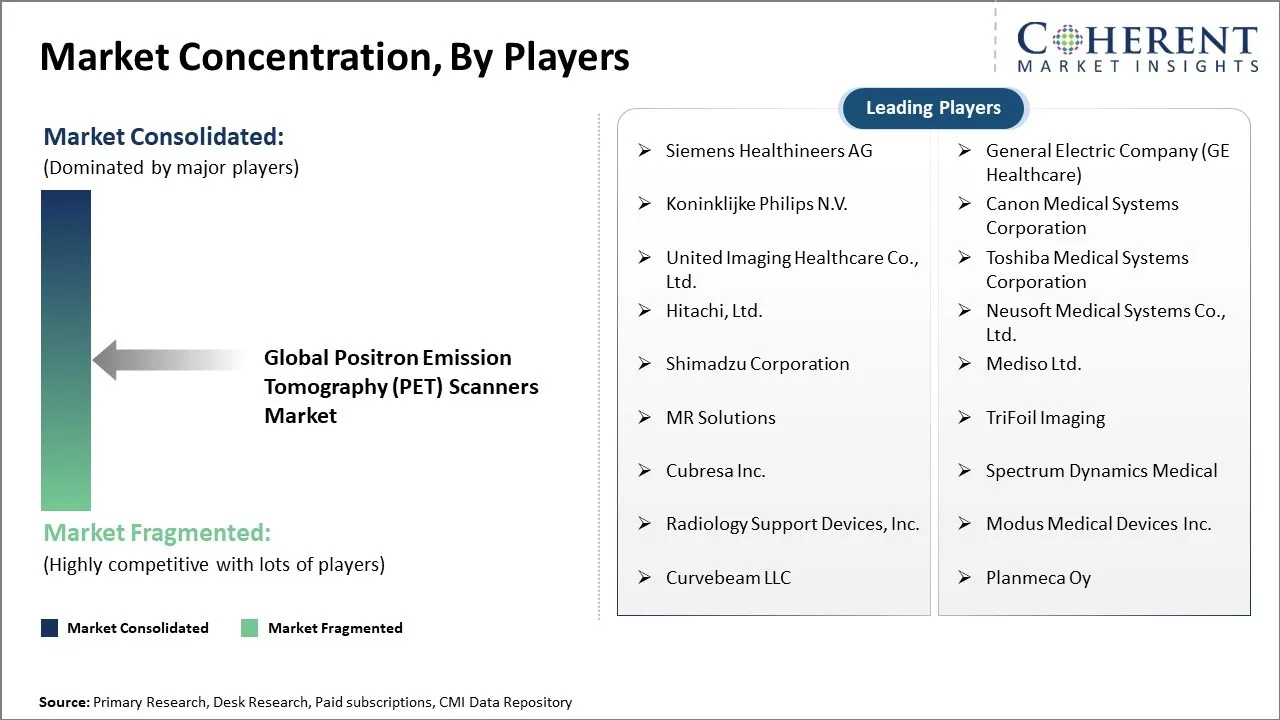
The global positron emission tomography (PET) scanners market is estimated to be valued at USD 2.55 Bn in 2025 and is expected to reach USD 3.79 Bn by 2032, exhibiting a compound annual growth rate (CAGR) of 5.8% from 2025 to 2032.

To learn more about this report, Download Free Sample
The global positron emission tomography (PET) scanners market is expected to witness considerable growth during the forecast period due to the increasing prevalence of chronic diseases such as cancer and cardiovascular diseases. Continuous technological advancements in the development and quality of PET scanners, to provide high-resolution images, can also drive the market growth during the forecast period. Adoption of hybrid PET scanners integrated with CT or MRI can also drive the market growth.
|
Current Events |
Description and its impact |
|
Aging Global Population and Rising Cancer Incidence |
|
|
China's Healthcare Infrastructure Expansion and Technology Localization |
|
Uncover macros and micros vetted on 75+ parameters: Get instant access to report
In terms of product type, the full ring PET scanner segment is estimated to contribute the highest market share of 60.6% in 2025, owing to continuous technological advancements. Full ring PET scanners capture data from the entire circumference of the body simultaneously, thus providing better image resolution and reduced scanning time as compared to partial ring scanners. This advantage boosts demand across diverse medical settings. Novel innovations such as digital photon counting and time-of-flight technology have further enhanced the diagnostic capabilities of full-ring scanners. Their high-end configurations with upgraded detectors and data processing hardware allow procurement of finer anatomical details essential for accurate disease staging and treatment planning.
The ability of full ring scanners to effectively detect metastatic cancers and subtle abnormalities has cemented their role as indispensable tools in diverse clinical specialties, including cardiology. With continual R&D focused on performance optimization, affordability, and compact designs, the full ring scanners segment will witness growth shortly. For instance, in June 2025, Scotland’s first ever total-body PET scanner became operational at Edinburgh’s Royal Infirmary. It is jointly managed by the Universities of Edinburgh and Glasgow.
In terms of application, the oncology segment is estimated to contribute the highest market share of 40.5% in 2025, owing to the rising global incidence of cancer cases. Cancer has become one of the leading causes of mortality worldwide, with an estimated 19 million new cases reported annually, as per WHO data. Early and accurate diagnosis plays a critical role in successful cancer management. PET imaging utilizing radionuclides such as fluorodeoxyglucose (FDG) enables detection of primary tumors and metastases with high sensitivity and specificity. This ability to map tumor metabolism at the cellular level has widened PET's clinical utility across diverse cancer types for diagnostic, staging, and restaging purposes. PET also aids chemotherapy response monitoring and tumor recurrence follow-up. With a continually aging population concurrently dealing with other cancer risk factors such as obesity and lack of physical activity, cancer incidences will increase shortly. This looming disease burden can boost demand for PET services within the oncology segment.
In terms of detector type, the lutetium oxyorthosilicate (LSO) segment is estimated to contribute the highest market share of 34.5% in 2025, owing to its superior performance attributes over other detector materials. LSO crystals offer high photo-fraction and stopping power due to their high effective atomic number and density. This allows them to efficiently absorb 511 keV annihilation photons and produce signals with good timing precision. LSO crystals demonstrate high light output, resulting in superior spatial resolution, thus enabling better delineation of anatomical structures and small lesions.
LSO detectors also exhibit low intrinsic background noise and minimal afterglow effects, enabling rapid acquisition of high-quality PET images. Their properties have facilitated the development of PET systems with time-of-flight capabilities and digital photon-counting for enhanced lesion detection. With ongoing innovations to further optimize light yield and reduce cost, LSO is anticipated to maintain its predominance in detector technology owing to advantages such as superior image noise characteristics and lesion contrast. In June 2024, Siemens Healthineers introduced the Biograph Trinion PET/CT scanner, featuring LSO crystal detectors. It offers high spatial resolution, ultrafast time-of-flight performance at 239 picoseconds, and effective sensitivity up to 128 cps/kBq, enabling rapid scans and reduced radiation doses.
Based on the End User insights, the Hospitals segment is expected to dominate the market in 2025. The growth of this segment can be attributed to a high volume of patients, integrated referral networks, insurance coverage for PET procedures, etc. However, the diagnostic imaging centers industry is also a rapidly growing segment. The growth is fuelled by the rise in outpatient demand for comprehensive imaging service, investments in healthcare facilities, and decreasing costs of PET systems.

To learn more about this report, Download Free Sample
North America dominates the global positron emission tomography (PET) scanners market with an estimated market share of 41.7% in 2025, owing to strong industry presence and high healthcare expenditure in the U.S. and Canada. The region is home to most of the major PET scanner OEMs as well as radio pharmacies supplying radiotracers required for PET imaging procedures. Higher acceptance of PET as a diagnostic imaging modality relative to other regions drives the market growth. Moreover, favorable reimbursement policies have made PET scans affordable for patients.
The United States is the largest market in the North American region. It dominates the PET scanner market due to various reasons, including an increase in healthcare spending, advancements in diagnostic infrastructure, high usage in oncology, cardiology, etc., along with an increase in the preference for PET/ CT scanners, which is also driving the market. For instance, as per a report published by Cardiovascular Business, in September 2024, the use of PET scanners rose by 25% among U.S. cardiologists between 2018 and 2022, making it the second most used modality for examining coronary artery disease.
Canada follows the U.S. It is the second-largest market in North America. The growth of the market in this region can be attributed to the growing support from the government for medical imaging and cancer screenings to increase awareness. High amounts of investments in public healthcare systems, collaborations taking place between hospitals and research centres, etc., are driving the market’s growth in Canada. For instance, in June 2025, Siemens Healthineers’ Biograph Trinion PET/CT scanners got the license from Health Canada. It is available all over Canada and is used for advanced diagnosis.
Asia Pacific region, excluding Japan, is poised to be the fastest-growing market for PET scanners. Rapid economic development and rising healthcare investments in countries such as China and India have increased patient access to advanced diagnostic technologies. The growing incidence of cancer and cardiac ailments has led to higher demand for PET procedures. Local manufacturers are also expanding their production capacities to cater to the domestic demand. PET services providers from developed markets are entering emerging nations by establishing new operation centres or through partnerships with local players. This is expected to boost the import of scanners as well as radiotracers in the coming years.
China dominates the Asia Pacific Positron Emission Tomography Scanners Market. This domination can be attributed to a wide range of factors, including a large aging population in the country, which leads to a rise in the number of patients with chronic diseases. Upgradation in hospital technology and support from the government are driving the market. For instance, in September 2023, NMPA gave approval to Florbetaben F‑18, which became China’s first approved amyloid-PET radiotracer for Alzheimer’s diagnosis.
India is the second-largest market for PET scanners in the Asia Pacific region. It is an emerging market that is witnessing a robust growth due to the prevalence of cancer cases, increasing awareness regarding health, and government initiatives to improve the healthcare infrastructure. For instance, in May 2025, Mahajan Imaging &Labs in Gurugram, India, launched North India’s first ever digital AI-powered PET-CT Omni Legend machine. It can be used to enhance accuracy, speed, and early detection.

To learn more about this report, Download Free Sample
| Report Coverage | Details | ||
|---|---|---|---|
| Base Year: | 2024 | Market Size in 2025: | USD 2.55 Bn |
| Historical Data for: | 2020 To 2024 | Forecast Period: | 2025 To 2032 |
| Forecast Period 2025 to 2032 CAGR: | 5.8% | 2032 Value Projection: | USD 3.79 Bn |
| Geographies covered: |
|
||
| Segments covered: |
|
||
| Companies covered: |
Siemens Healthineers AG, General Electric Company (GE Healthcare), Koninklijke Philips N.V., Canon Medical Systems Corporation, United Imaging Healthcare Co., Ltd., Toshiba Medical Systems Corporation, Hitachi, Ltd., Neusoft Medical Systems Co., Ltd., Shimadzu Corporation, Mediso Ltd., MR Solutions, TriFoil Imaging, Cubresa Inc., Spectrum Dynamics Medical, Radiology Support Devices, Inc., Modus Medical Devices Inc., Curvebeam LLC, Planmeca Oy |
||
| Growth Drivers: |
|
||
| Restraints & Challenges: |
|
||
Uncover macros and micros vetted on 75+ parameters: Get instant access to report
The rising burden of cancer and cardiovascular diseases can drive the market growth. As per the data from the WHO, cancer accounted for nearly 10 million deaths in 2020 worldwide. Key factors contributing to cancer incidence include the growing prevalence of risk factors such as smoking, obesity, physical inactivity, and changing lifestyle habits. Cardiovascular diseases remain the top cause of mortality, with over 17 million deaths reported annually, as per the WHO.
Aging population worldwide and increasing life expectancy have further contributed to escalating cases of cancer and heart conditions, which often require medical imaging for accurate diagnosis and staging of the disease. PET scanning has emerged as an important imaging modality, owing to its high sensitivity and ability to detect even small malignant tumors or early signs of heart diseases. Its utilization continues to grow rapidly, especially in developed nations, for cancer screening and detection of recurrence. This growing disease burden, as well as emphasis on early detection, can boost demand for PET scanners.
PET scanning technology has witnessed substantial evolution over the past decades. The emergence of hybrid PET-CT imaging, where both anatomical and metabolic information can be obtained from a single scan session, has remarkably increased the clinical applications of PET imaging. PET-CT scanner device is now considered the standard of care for accurate cancer staging, treatment planning, therapy response assessment, and detecting relapse or metastasis. Its high diagnostic value in oncology compared to other conventional imaging modalities like CT, MRI, or ultrasound has boosted the installation of PET-CT systems globally.
Moreover, oncologists are relying more on PET-CT for tumor imaging, considering its ability to detect cancer recurrence earlier than other tests. Reimbursement policies in several countries now cover PET-CT for various cancer indications. Therefore, expanding clinical applications and growing insurance coverage for PET-CT scans in cancer management across hospitals and diagnostic centers worldwide can boost demand for PET scanners. Manufacturers are also introducing new generation PET-CT devices with faster acquisition time, enhanced resolution, and throughput, which boosts their adoption rate in clinical oncology practice.
The application of PET scans in neurology and cardiology provides immense scope and opportunity for the global positron emission tomography (PET) scanners market. PET scanning uses radioactive tracers to help reveal molecular processes in the body. It has revolutionized the field of neurological and cardiac diagnostics in recent times. PET scans help identify the presence and extent of many neurological conditions non-invasively. Diseases like Alzheimer's, stroke, epilepsy, brain tumors, and Parkinson's disease leave distinct biochemical signatures that PET is exceptionally sensitive in detecting. Its utilization is growing rapidly for both research and clinical purposes in neurology. For instance, according to a 2021 report published by the World Health Organization, dementia affects over 55 million people worldwide currently and is projected to nearly triple to 152 million by 2050 due to the aging global population.
PET scans play a pivotal role in the accurate diagnosis and monitoring of different types of dementia. In cardiology, PET scans have emerged as a powerful tool for the diagnosis of coronary artery disease. It can identify vulnerable plaque in arteries that may rupture and cause a heart attack. PET is also widely used for the assessment of myocardial viability, which has implications in decisions around revascularization procedures. In 2020, a study published in the European Heart Journal found that routine use of PET imaging led to improved patient outcomes and significantly lower healthcare costs through better identification of patients who would benefit most from invasive treatments like bypass surgery.
*Definition: Positron Emission Tomography or PET scanners are medical imaging devices that help doctors diagnose and manage diseases. PET scanners detect gamma rays emitted indirectly by a positron-emitting radionuclide (tracer), which is introduced into the body on a biologically active molecule. The three-dimensional anatomical images provided by PET scanners allow practitioners to see how organs and tissues are functioning, to accurately detect and localize tumors, determine the stage of some cancers, and guide treatment.
Share
Share
About Author
Komal Dighe is a Management Consultant with over 8 years of experience in market research and consulting. She excels in managing and delivering high-quality insights and solutions in Health-tech Consulting reports. Her expertise encompasses conducting both primary and secondary research, effectively addressing client requirements, and excelling in market estimation and forecast. Her comprehensive approach ensures that clients receive thorough and accurate analyses, enabling them to make informed decisions and capitalize on market opportunities.
Missing comfort of reading report in your local language? Find your preferred language :
Transform your Strategy with Exclusive Trending Reports :
Frequently Asked Questions
Joining thousands of companies around the world committed to making the Excellent Business Solutions.
View All Our Clients